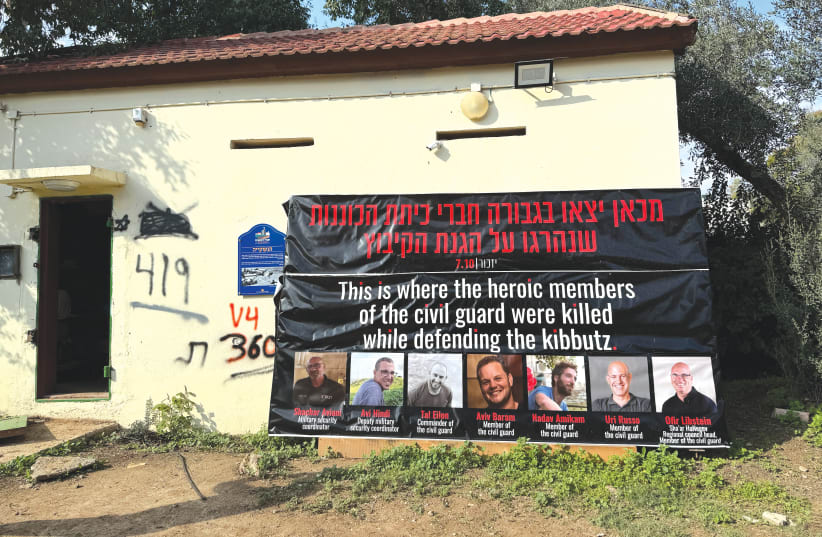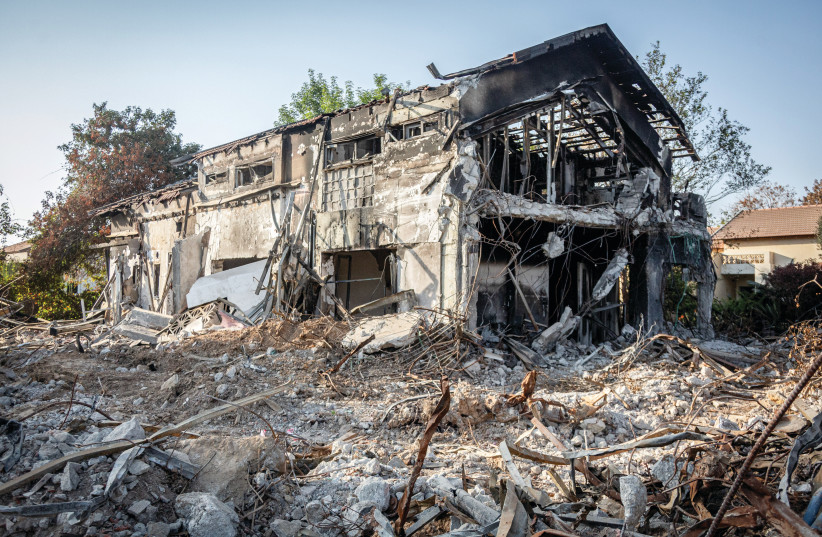For 89 days, I hesitated. I wanted to protect my soul from blood-splattered floors, from embers that had once been humans, from evidence of rape – GoPro-ed, then broadcast worldwide by sickos. Then, as more celebrities visited and the selfie-fest-amid-the-ruins began, I feared being what one friend called a “terror tourist,” a voyeur, empathy-signaling amid my people’s pain.
But last Wednesday, when I visited Kibbutz Kfar Aza, I realized I erred. We – meaning every civilized person – should fly thousands of miles, endure hours of waiting – whatever it takes! – to see the evil that so many Gazans unleashed upon us on October 7.
Let them see that “us” includes men and women, young and old, dark-skinned and light-skinned, religious and non-religious, Jews and non-Jews. And let them see that “us” includes all who cherish life; who respect civilization’s rules; who know you don’t rape, maim, behead, and torture innocents, even if you hate your neighbors.
An eerie beauty
The oddest thing about wandering these kibbutzim along the Gaza border area is how beautiful they remain. These farming collectives made the desert bloom. Each hut testifies to those touches that make life worth living – while reflecting the peculiar art of being a kibbutznik.
Your old-fashioned LP record marks your address, standing out amid the look-alike houses. You arrange old couches outside to hang out together into the night. Upgrading, you get a washer-dryer – but keep it outside your small house too.
Seeing these refinements – let alone that Zionist symbol, an orange tree, juxtaposed against burned houses, bullet holes, and photos of the missing and dead – is devastating. Each ruined home, each life destroyed, and each horrific story told demonstrates the gap between our good and their evil.
Our guide, Yossi Landau, helped found ZAKA, those mostly ultra-Orthodox volunteers who collect blood, bodies, and body parts after calamities. The Hebrew acronym for Disaster Victim Identification, ZAKA, also stands for Zeh Keiruv Achim – this brings us together – which ZAKA has been doing since 1995.
Haunting memories
Yossi explains that Jews collect spilled blood because “you can live without a limb or without an eye, but you can’t live without blood.” Those words resonate particularly painfully after October 7. That day, Yossi scrambled from his home in Ashdod, fought terrorists in Sderot, then spent a month supervising ZAKA’s gruesome task. While describing the Hamas savagery he witnessed, he usually spoke quietly, clinically.
Suddenly, he wonders, in anguish, when he recalls seeing the corpses of a brutalized family, whether it was worse if the children saw their parents die first or if the parents saw their children die. No one should ever have to contemplate such questions – let alone endure such monstrosities.
Recalling that scene, where two parents and two kids were each bound together and suffered unspeakable horrors, he and 11 other volunteers entered the house cautiously, having been warned. There wasn’t “just a pool of blood, but a lake of blood,” Yossi recalls. Silently, instinctively, they just sat down in the blood, absorbing it.
“We then sang songs of hope,” he says: “Vehee Sheamda,” the Passover song affirming that our enemies keep trying to destroy us, but God keeps saving us from their bloody hands; and “Ani Ma’amin,” the gas chambers’ anthem, affirming our faith that the Messiah will come, soon.
Intellectually and politically, the hardest site for me was a lovely grassy area in the heart of Kfar Aza. Hanging on a simple red-roofed building, a sign picturing seven kibbutzniks proclaims: “This is where the heroic members of the civil guard were killed while defending the kibbutz.” The Hamas invaders waited across from that building – the armory – then ambushed the kibbutz’s guards.
Painful reminders
THIS SITE represents October 7’s many levels of failure. First, just as the government tolerated Hamas’s bombardments and then built safe rooms that couldn’t be locked because they “only” expected rockets from Gaza, the government tolerated Bedouin thievery and then forced everyone to lock their guns in the armory. Why did they always dodge the underlying problems?
Alas, few objected because everyone “knew” we had an impregnable fence, unbelievable intelligence, and a third-rate foe who would give us warning time to arm if we ever needed to defend ourselves.
Finally, succumbing to international pressure, the government let so many Gazans work at the kibbutzim. The Palestinians amassed perfect intelligence, learning how our defenders would react – and where the armories were located. Any “day after” analysis, which addresses specific operational and intelligence failures, without probing governmental incompetence and arrogance, will be as successful as Israel’s NIS 3.5 billion Gaza fence.
Back home, while planning to return to learn more, especially to see Sderot and Ofakim and understand the resistance that saved those cities, I still struggled with “why go.” I turned for wisdom to my late professor, Elie Wiesel. In his 1986 Nobel Peace Prize lecture, Wiesel explained the survivors’ need to remember, record, and testify.
Prof. Wiesel was not naïve. Although knowing that remembering couldn’t prevent evil, he appreciated the twin powers of memory. “Remembering is a noble and necessary act,” he taught. “It is incumbent upon us to remember the good we have received and the evil we have suffered.”
Visiting the South, you cannot forget the evil that every victim suffered, that we suffered. Touring the kibbutzim, you cannot forget the good that the kibbutznikim and their neighbors created. And witnessing the destruction, you vow that we cannot stop fighting until every Israeli can return home in safety, resume their lives, and keep building and beautifying. Each of our affirmations of life defeats the Palestinian death cult, which seeks to deprive us of our joy.
The writer, a senior fellow in Zionist thought at the Jewish People Policy Institute, is an American presidential historian and the editor of a three-volume set, Theodor Herzl: Zionist Writings, the inaugural publication of The Library of the Jewish People (www.theljp.org).

